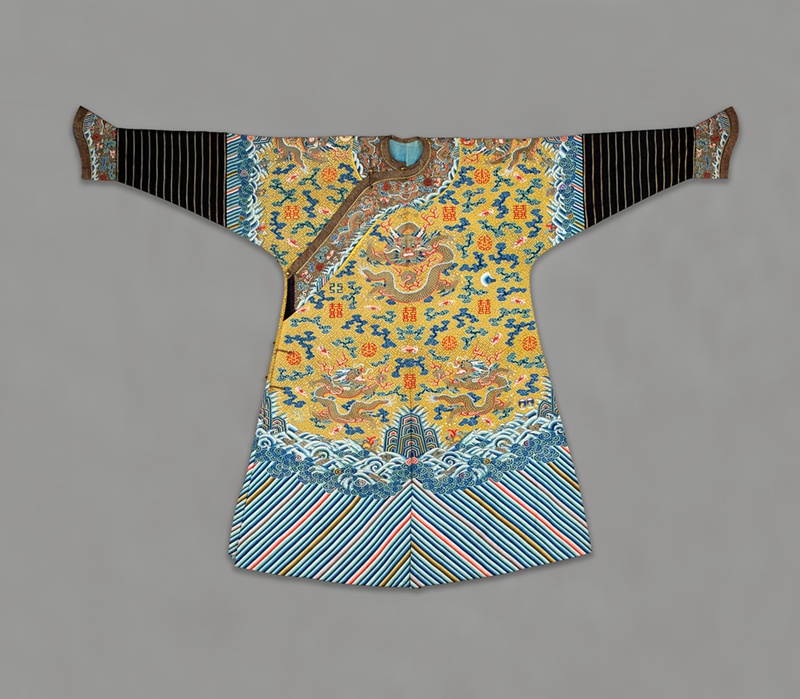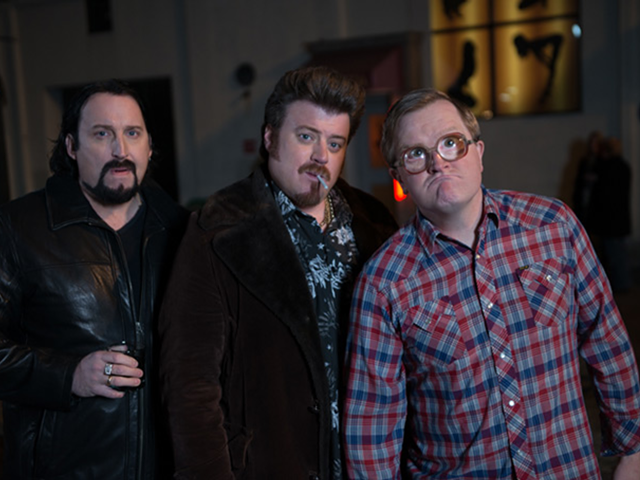Have you seen the emperor’s old clothes at the Taft Museum of Art?
With apologies to Hans Christian Andersen’s cautionary tale of vanity, the naked truth remains that we’re judged by our dress. The imperial robes in Threads of Heaven: Silken Legacy of China’s Last Dynasty are laden with symbols of status as well as emblems of happiness and luck. The fine embroidery itself demands a close look.
The Qing (pronounced “Ching”) Dynasty stretched from 1644 to 1911. The Manchu who conquered China held control, but their population was smaller than that of the ethnic Chinese. To create a sense of legitimacy yet maintain their identity, they modified the Chinese style of dress. The exhibit from the Denver Art Museum features clothes and accessories mainly from 1850 to the end of the reign.
The yellow his-and-her semiformal court robes at the entrance make a strong first impression. By law, only the imperial family could wear the color. (Is this why the yellow power tie still rules today?)
The symbols on the robes are Chinese, but the cut is Manchu — narrow, with practical slits on the front, back and sides for horseback riding. Horse-hoof cuffs distinguish the sleeves from predecessors’ standard robe cuffs. The flared cuffs are a decorative nod to Manchus’ heritage as nomadic horsemen, as well as protection for the hands.
An embroidered ceremonial textile featuring dragons and phoenixes hangs behind the robes. The animals are symbols of the emperor and empress. The entire realm — the sea, mountains, a pagoda, books and scrolls — spreads out before the visitor, and an intimidating dragon appears to stare in judgment.
“We wanted to immediately create the impact of how textiles functioned in imperial China,” says Lisa Morrisette, the exhibit’s installing curator and the Taft’s manager of school and docent programs.
Discovering the meanings of the emblems is like learning a second language. Bats are creepy symbols in Western culture but icons of happiness to the Chinese, as their word for bat is pronounced “fu,” and so is their word for good luck.
Bats are plentiful, but only the emperor and empress could wear the 12 symbols of imperial power representing the seasons, elements and the realms of earth and sky. Five-clawed dragons also were reserved for the emperor and family, so a missing nail is a clue to the wearer’s status. A forward-facing dragon carries more weight than one looking sideways. In today’s terms, these status symbols are the difference between carrying a Coach bag or a knockoff, says Morrisette.
We disparage a product made in modern China as mass-produced and of cheap quality. But during the Qing era, it could take one person more than two years to embroider a robe. Glass-enclosed displays of rank badges and sleeve bands allow visitors to study the careful, detailed work. Dozens of tiny forbidden knots (named after the Forbidden City, where they were created) fill an outline like dots in a Georges Seurat painting. Discs of shimmering metal thread are cut from gold leaf. A few small stitches convey a mother’s sweet smile or a child’s dancing eyes in a story decorating a robe’s cuffs.
Earrings, hairpins and a wedding headdress include the blue plumage of the kingfisher, a bird hunted nearly to extinction. The iridescent feathers are placed so closely together in metal settings that they resemble enamel.
Other displays highlight ingenuity in addition to craftsmanship. Morrisette refers to an open-weave jacket of bamboo as “Chinese underwear.” It was worn under a robe in summer to cool the body. An array of purses and small cases also demonstrates practicality as well as individual expression. Because Chinese robes had no pockets, fans, tobacco and eyeglasses were carried in these pouches.
“Extreme Dressing” sums up the final display, featuring teeny shoes for women’s bound feet. At such a small size — a 4-inch-long foot was considered the ideal — and with their pointy, downward tips, the slippers are barely recognizable as footwear. The Manchu forbid foot binding, but to mimic the alluring, swaying gait it created, some women wore a platform shoe that resembles a cross between a ballet flat and a mushroom.
Foot binding aside, it’s tough to fight fashion. The Cincinnati Art Museum scored with spiked “Fang Shoes” in its recent What’s New: Fashion and Contemporary Craft exhibit. As odd as the Manchu platform shoes look, maybe those status symbols were just a century ahead of their time.
THREADS OF HEAVEN: SILKEN LEGACY OF CHINA’S LAST DYNASTY is on display through May 18 at the Taft Museum of Art (316 Pike St., Downtown). Morrisette will give a gallery talk 1:30 p.m. May 9; free with admission. More: taftmuseum.org.






